Laburnum Group: Strategic Supply Chain Analysis and Improvement Plan
VerifiedAdded on 2023/04/19
|8
|2530
|182
Case Study
AI Summary
This case study analyzes the supply chain operations of Laburnum Group, focusing on both its energy (Sapphire Energy) and clothing (AusCotton) portfolios. For Sapphire Energy, the effectiveness of the current ordering system is evaluated using the Economic Order Quantity (EOQ) model, revealing inefficiencies due to mandated minimum order quantities. Recommendations include negotiating for lower minimum order quantities to optimize costs. For AusCotton, global strategic sourcing challenges such as cultural norms, language barriers, and financial complexities are discussed, along with the impacts of imperfect demand forecasts and transport volatility. Solutions to forecasting problems involve defining the market, considering variables like competition and seasonality, and using economic factors to predict transport costs. Improvements to the strategic sourcing process include building commitment with suppliers, adopting a cost analysis mindset, and enhancing coordination between AusCotton and its manufacturers. Finally, strategies to combat the production of counterfeit products are outlined, emphasizing open market policies and partnerships with reputable companies. The study concludes with recommendations for optimizing the supply chain and mitigating risks in the global business environment.
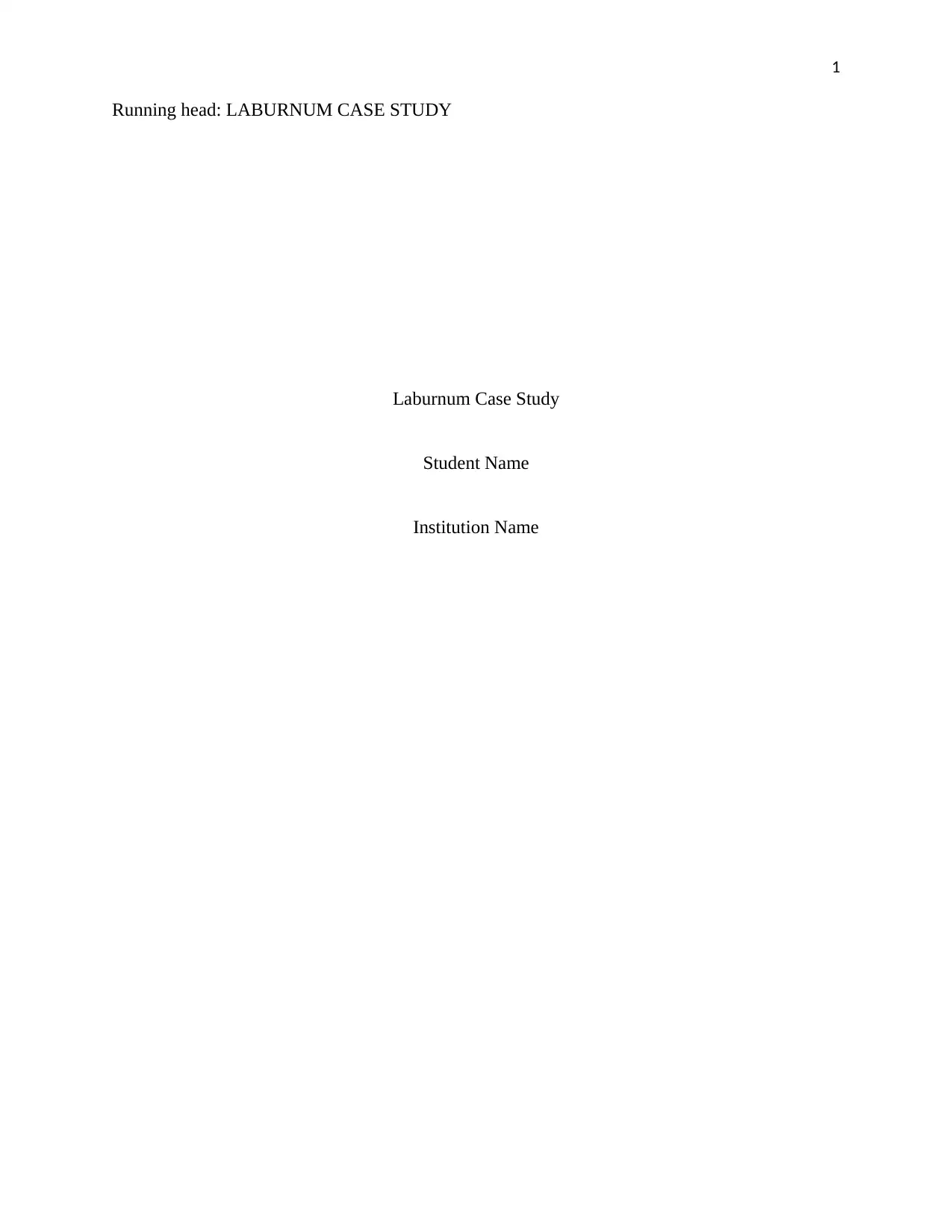
1
Running head: LABURNUM CASE STUDY
Laburnum Case Study
Student Name
Institution Name
Running head: LABURNUM CASE STUDY
Laburnum Case Study
Student Name
Institution Name
Paraphrase This Document
Need a fresh take? Get an instant paraphrase of this document with our AI Paraphraser

2
LABURNUM CASE STUDY
Introduction
Laburnum group was formulated in 1920 as a farmer’s cooperative, from there it has
risen to be one of the largest listed companies in Australia with operating headquarters in
Victoria. Laburnum group operates diverse business area; energy clothing being one of them.
The AusCotton section of the company specialises in clothing while Sapphire energy is the
branch concerned with the supply of energy. As a way of optimising the firm’s profitability, the
management takes keen interest on the business internal processes. Due to the various factors
affecting the organization, this report will analyse Laburnum supply chain as well as the nature
of the global business challenges. Afterwards a recommendation will be made to the
administration of the company to assist improve overall performance.
Energy Portfolio: Sapphire Energy
Effectiveness of the current ordering system
To gauge the effectiveness of the ordering system, the Economic Order Quantity (EOQ)
value is applied. This is a measurement in the field of supply chain that assist determine the
volume and frequency of orders that is required to meet a certain level of demand while at the
same time minimizing the cost of each order (Sandun, Ganesh, & Shun-Chen, 2017). It is given
by the formula;
EOQ= √ 2 SD
H
Where S is the ordering cost, D the annual quantity demanded and H the holding cost.
D is given as 155000, S is $50, while H is
H=iC
Where i is the interest rate and C the unit cost.
Hence H=1.35
EOQ= √ 2∗50∗155000
1.35 =3388.43 m
Under the current system three conditions have to be met, that is
No quantity discount is allowed
A minimum of 4500m is needed for each order.
The eastern power store room needs to take 1/12) of its annual need monthly that is
12916.67m.
LABURNUM CASE STUDY
Introduction
Laburnum group was formulated in 1920 as a farmer’s cooperative, from there it has
risen to be one of the largest listed companies in Australia with operating headquarters in
Victoria. Laburnum group operates diverse business area; energy clothing being one of them.
The AusCotton section of the company specialises in clothing while Sapphire energy is the
branch concerned with the supply of energy. As a way of optimising the firm’s profitability, the
management takes keen interest on the business internal processes. Due to the various factors
affecting the organization, this report will analyse Laburnum supply chain as well as the nature
of the global business challenges. Afterwards a recommendation will be made to the
administration of the company to assist improve overall performance.
Energy Portfolio: Sapphire Energy
Effectiveness of the current ordering system
To gauge the effectiveness of the ordering system, the Economic Order Quantity (EOQ)
value is applied. This is a measurement in the field of supply chain that assist determine the
volume and frequency of orders that is required to meet a certain level of demand while at the
same time minimizing the cost of each order (Sandun, Ganesh, & Shun-Chen, 2017). It is given
by the formula;
EOQ= √ 2 SD
H
Where S is the ordering cost, D the annual quantity demanded and H the holding cost.
D is given as 155000, S is $50, while H is
H=iC
Where i is the interest rate and C the unit cost.
Hence H=1.35
EOQ= √ 2∗50∗155000
1.35 =3388.43 m
Under the current system three conditions have to be met, that is
No quantity discount is allowed
A minimum of 4500m is needed for each order.
The eastern power store room needs to take 1/12) of its annual need monthly that is
12916.67m.

3
LABURNUM CASE STUDY
Currently the firm has to make a minimum purchase of 4500m per order which is higher than the
EOQ hence does not optimize the business operation costs.
Assuming a uniform demand of the material per week, the weekly demand will be
155000
52.1429 =approximately 2973 m. Without the current deal the lead time is 12 weeks which
means the Eastern power storeroom need to have 35,676m of the cable at the time of placing an
order (Caplin & Leahy, 2010). The current system even though account for the lead time, its
quantity per order is not economical and hence needs to be revised.
Suggested improvements
One of the areas that need to be improved is the order quantity, the current system entails
making a minimum of 4500m per order. Even though this meets the monthly demand of
Sapphire energy, it does not optimize the costs of operations. Making an order similar to the
EOQ will mean forfeiting the current deal and hence having to encounter the 12 weeks lead time
(Elyasi, Khoshalhan, & Khanmirzaee, 2014). This will mean an increased acceptable minimum
stock level a factor that will go ahead to increase the inventory holding cost. So as to optimise
the operations of Sapphire, the company need to negotiate for a lower minimum quantity that can
be ordered at a given time to reflect the EOQ value. This will allow the firm to minimise the cost
of operations while at the same time maintaining a stock level that can sustain daily service
delivery of the firm.
Clothing Portfolio: AusCotton
Global issues affecting strategic sourcing
By definition strategic sourcing is a technique applied in the supply chin management
process that entails formalising the methods of data collection and application. This enable a firm
leverage its consolidated purchasing power as away of finding the best possible market values. It
demands an analysis of what the firm needs to buy, who they buy from, the volume of purchase
as well as the prices (Roth & Pullman, 2008). The process of strategic sourcing is globally
affected by a number of challenges, some includes;
Diverse cultural norms, a firm that undertakes global strategic sourcing is occasionally
faced with different cultures that practice unique ways of doing business. This cultural variation
demands that a firm have a set of employees that are able to mitigate the barriers so as to get the
best deals in the market. Also, language barrier is another challenge that interferes with strategic
LABURNUM CASE STUDY
Currently the firm has to make a minimum purchase of 4500m per order which is higher than the
EOQ hence does not optimize the business operation costs.
Assuming a uniform demand of the material per week, the weekly demand will be
155000
52.1429 =approximately 2973 m. Without the current deal the lead time is 12 weeks which
means the Eastern power storeroom need to have 35,676m of the cable at the time of placing an
order (Caplin & Leahy, 2010). The current system even though account for the lead time, its
quantity per order is not economical and hence needs to be revised.
Suggested improvements
One of the areas that need to be improved is the order quantity, the current system entails
making a minimum of 4500m per order. Even though this meets the monthly demand of
Sapphire energy, it does not optimize the costs of operations. Making an order similar to the
EOQ will mean forfeiting the current deal and hence having to encounter the 12 weeks lead time
(Elyasi, Khoshalhan, & Khanmirzaee, 2014). This will mean an increased acceptable minimum
stock level a factor that will go ahead to increase the inventory holding cost. So as to optimise
the operations of Sapphire, the company need to negotiate for a lower minimum quantity that can
be ordered at a given time to reflect the EOQ value. This will allow the firm to minimise the cost
of operations while at the same time maintaining a stock level that can sustain daily service
delivery of the firm.
Clothing Portfolio: AusCotton
Global issues affecting strategic sourcing
By definition strategic sourcing is a technique applied in the supply chin management
process that entails formalising the methods of data collection and application. This enable a firm
leverage its consolidated purchasing power as away of finding the best possible market values. It
demands an analysis of what the firm needs to buy, who they buy from, the volume of purchase
as well as the prices (Roth & Pullman, 2008). The process of strategic sourcing is globally
affected by a number of challenges, some includes;
Diverse cultural norms, a firm that undertakes global strategic sourcing is occasionally
faced with different cultures that practice unique ways of doing business. This cultural variation
demands that a firm have a set of employees that are able to mitigate the barriers so as to get the
best deals in the market. Also, language barrier is another challenge that interferes with strategic
⊘ This is a preview!⊘
Do you want full access?
Subscribe today to unlock all pages.

Trusted by 1+ million students worldwide
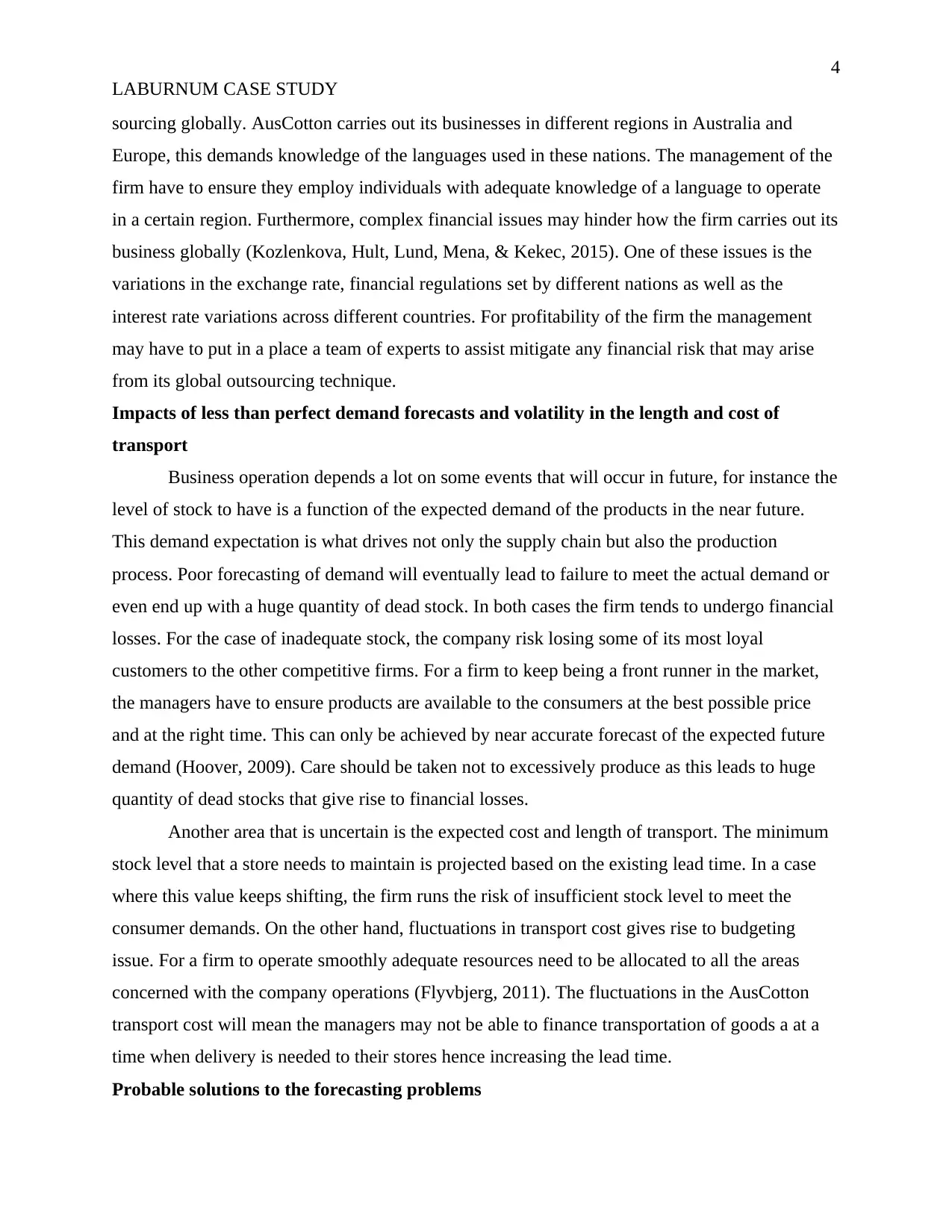
4
LABURNUM CASE STUDY
sourcing globally. AusCotton carries out its businesses in different regions in Australia and
Europe, this demands knowledge of the languages used in these nations. The management of the
firm have to ensure they employ individuals with adequate knowledge of a language to operate
in a certain region. Furthermore, complex financial issues may hinder how the firm carries out its
business globally (Kozlenkova, Hult, Lund, Mena, & Kekec, 2015). One of these issues is the
variations in the exchange rate, financial regulations set by different nations as well as the
interest rate variations across different countries. For profitability of the firm the management
may have to put in a place a team of experts to assist mitigate any financial risk that may arise
from its global outsourcing technique.
Impacts of less than perfect demand forecasts and volatility in the length and cost of
transport
Business operation depends a lot on some events that will occur in future, for instance the
level of stock to have is a function of the expected demand of the products in the near future.
This demand expectation is what drives not only the supply chain but also the production
process. Poor forecasting of demand will eventually lead to failure to meet the actual demand or
even end up with a huge quantity of dead stock. In both cases the firm tends to undergo financial
losses. For the case of inadequate stock, the company risk losing some of its most loyal
customers to the other competitive firms. For a firm to keep being a front runner in the market,
the managers have to ensure products are available to the consumers at the best possible price
and at the right time. This can only be achieved by near accurate forecast of the expected future
demand (Hoover, 2009). Care should be taken not to excessively produce as this leads to huge
quantity of dead stocks that give rise to financial losses.
Another area that is uncertain is the expected cost and length of transport. The minimum
stock level that a store needs to maintain is projected based on the existing lead time. In a case
where this value keeps shifting, the firm runs the risk of insufficient stock level to meet the
consumer demands. On the other hand, fluctuations in transport cost gives rise to budgeting
issue. For a firm to operate smoothly adequate resources need to be allocated to all the areas
concerned with the company operations (Flyvbjerg, 2011). The fluctuations in the AusCotton
transport cost will mean the managers may not be able to finance transportation of goods a at a
time when delivery is needed to their stores hence increasing the lead time.
Probable solutions to the forecasting problems
LABURNUM CASE STUDY
sourcing globally. AusCotton carries out its businesses in different regions in Australia and
Europe, this demands knowledge of the languages used in these nations. The management of the
firm have to ensure they employ individuals with adequate knowledge of a language to operate
in a certain region. Furthermore, complex financial issues may hinder how the firm carries out its
business globally (Kozlenkova, Hult, Lund, Mena, & Kekec, 2015). One of these issues is the
variations in the exchange rate, financial regulations set by different nations as well as the
interest rate variations across different countries. For profitability of the firm the management
may have to put in a place a team of experts to assist mitigate any financial risk that may arise
from its global outsourcing technique.
Impacts of less than perfect demand forecasts and volatility in the length and cost of
transport
Business operation depends a lot on some events that will occur in future, for instance the
level of stock to have is a function of the expected demand of the products in the near future.
This demand expectation is what drives not only the supply chain but also the production
process. Poor forecasting of demand will eventually lead to failure to meet the actual demand or
even end up with a huge quantity of dead stock. In both cases the firm tends to undergo financial
losses. For the case of inadequate stock, the company risk losing some of its most loyal
customers to the other competitive firms. For a firm to keep being a front runner in the market,
the managers have to ensure products are available to the consumers at the best possible price
and at the right time. This can only be achieved by near accurate forecast of the expected future
demand (Hoover, 2009). Care should be taken not to excessively produce as this leads to huge
quantity of dead stocks that give rise to financial losses.
Another area that is uncertain is the expected cost and length of transport. The minimum
stock level that a store needs to maintain is projected based on the existing lead time. In a case
where this value keeps shifting, the firm runs the risk of insufficient stock level to meet the
consumer demands. On the other hand, fluctuations in transport cost gives rise to budgeting
issue. For a firm to operate smoothly adequate resources need to be allocated to all the areas
concerned with the company operations (Flyvbjerg, 2011). The fluctuations in the AusCotton
transport cost will mean the managers may not be able to finance transportation of goods a at a
time when delivery is needed to their stores hence increasing the lead time.
Probable solutions to the forecasting problems
Paraphrase This Document
Need a fresh take? Get an instant paraphrase of this document with our AI Paraphraser
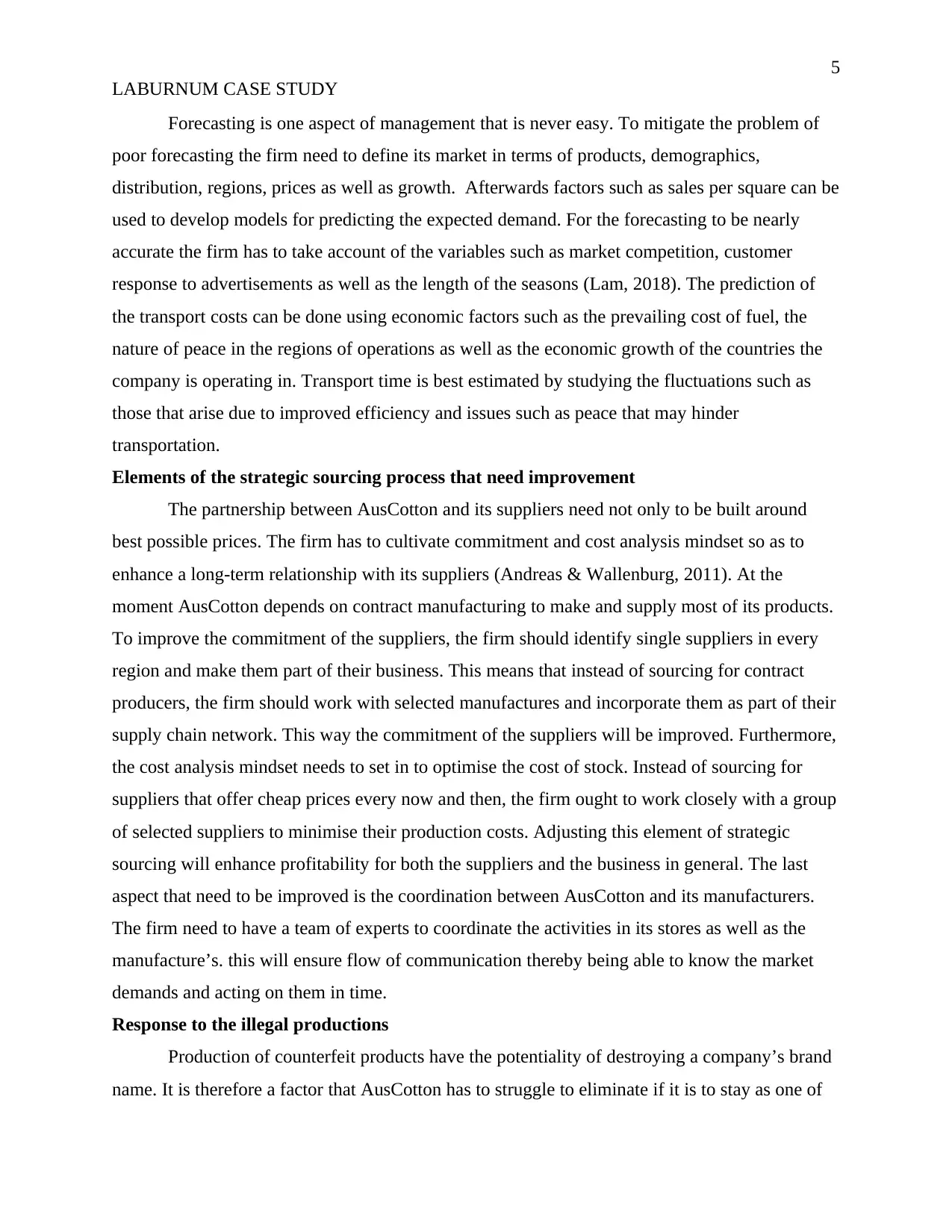
5
LABURNUM CASE STUDY
Forecasting is one aspect of management that is never easy. To mitigate the problem of
poor forecasting the firm need to define its market in terms of products, demographics,
distribution, regions, prices as well as growth. Afterwards factors such as sales per square can be
used to develop models for predicting the expected demand. For the forecasting to be nearly
accurate the firm has to take account of the variables such as market competition, customer
response to advertisements as well as the length of the seasons (Lam, 2018). The prediction of
the transport costs can be done using economic factors such as the prevailing cost of fuel, the
nature of peace in the regions of operations as well as the economic growth of the countries the
company is operating in. Transport time is best estimated by studying the fluctuations such as
those that arise due to improved efficiency and issues such as peace that may hinder
transportation.
Elements of the strategic sourcing process that need improvement
The partnership between AusCotton and its suppliers need not only to be built around
best possible prices. The firm has to cultivate commitment and cost analysis mindset so as to
enhance a long-term relationship with its suppliers (Andreas & Wallenburg, 2011). At the
moment AusCotton depends on contract manufacturing to make and supply most of its products.
To improve the commitment of the suppliers, the firm should identify single suppliers in every
region and make them part of their business. This means that instead of sourcing for contract
producers, the firm should work with selected manufactures and incorporate them as part of their
supply chain network. This way the commitment of the suppliers will be improved. Furthermore,
the cost analysis mindset needs to set in to optimise the cost of stock. Instead of sourcing for
suppliers that offer cheap prices every now and then, the firm ought to work closely with a group
of selected suppliers to minimise their production costs. Adjusting this element of strategic
sourcing will enhance profitability for both the suppliers and the business in general. The last
aspect that need to be improved is the coordination between AusCotton and its manufacturers.
The firm need to have a team of experts to coordinate the activities in its stores as well as the
manufacture’s. this will ensure flow of communication thereby being able to know the market
demands and acting on them in time.
Response to the illegal productions
Production of counterfeit products have the potentiality of destroying a company’s brand
name. It is therefore a factor that AusCotton has to struggle to eliminate if it is to stay as one of
LABURNUM CASE STUDY
Forecasting is one aspect of management that is never easy. To mitigate the problem of
poor forecasting the firm need to define its market in terms of products, demographics,
distribution, regions, prices as well as growth. Afterwards factors such as sales per square can be
used to develop models for predicting the expected demand. For the forecasting to be nearly
accurate the firm has to take account of the variables such as market competition, customer
response to advertisements as well as the length of the seasons (Lam, 2018). The prediction of
the transport costs can be done using economic factors such as the prevailing cost of fuel, the
nature of peace in the regions of operations as well as the economic growth of the countries the
company is operating in. Transport time is best estimated by studying the fluctuations such as
those that arise due to improved efficiency and issues such as peace that may hinder
transportation.
Elements of the strategic sourcing process that need improvement
The partnership between AusCotton and its suppliers need not only to be built around
best possible prices. The firm has to cultivate commitment and cost analysis mindset so as to
enhance a long-term relationship with its suppliers (Andreas & Wallenburg, 2011). At the
moment AusCotton depends on contract manufacturing to make and supply most of its products.
To improve the commitment of the suppliers, the firm should identify single suppliers in every
region and make them part of their business. This means that instead of sourcing for contract
producers, the firm should work with selected manufactures and incorporate them as part of their
supply chain network. This way the commitment of the suppliers will be improved. Furthermore,
the cost analysis mindset needs to set in to optimise the cost of stock. Instead of sourcing for
suppliers that offer cheap prices every now and then, the firm ought to work closely with a group
of selected suppliers to minimise their production costs. Adjusting this element of strategic
sourcing will enhance profitability for both the suppliers and the business in general. The last
aspect that need to be improved is the coordination between AusCotton and its manufacturers.
The firm need to have a team of experts to coordinate the activities in its stores as well as the
manufacture’s. this will ensure flow of communication thereby being able to know the market
demands and acting on them in time.
Response to the illegal productions
Production of counterfeit products have the potentiality of destroying a company’s brand
name. It is therefore a factor that AusCotton has to struggle to eliminate if it is to stay as one of
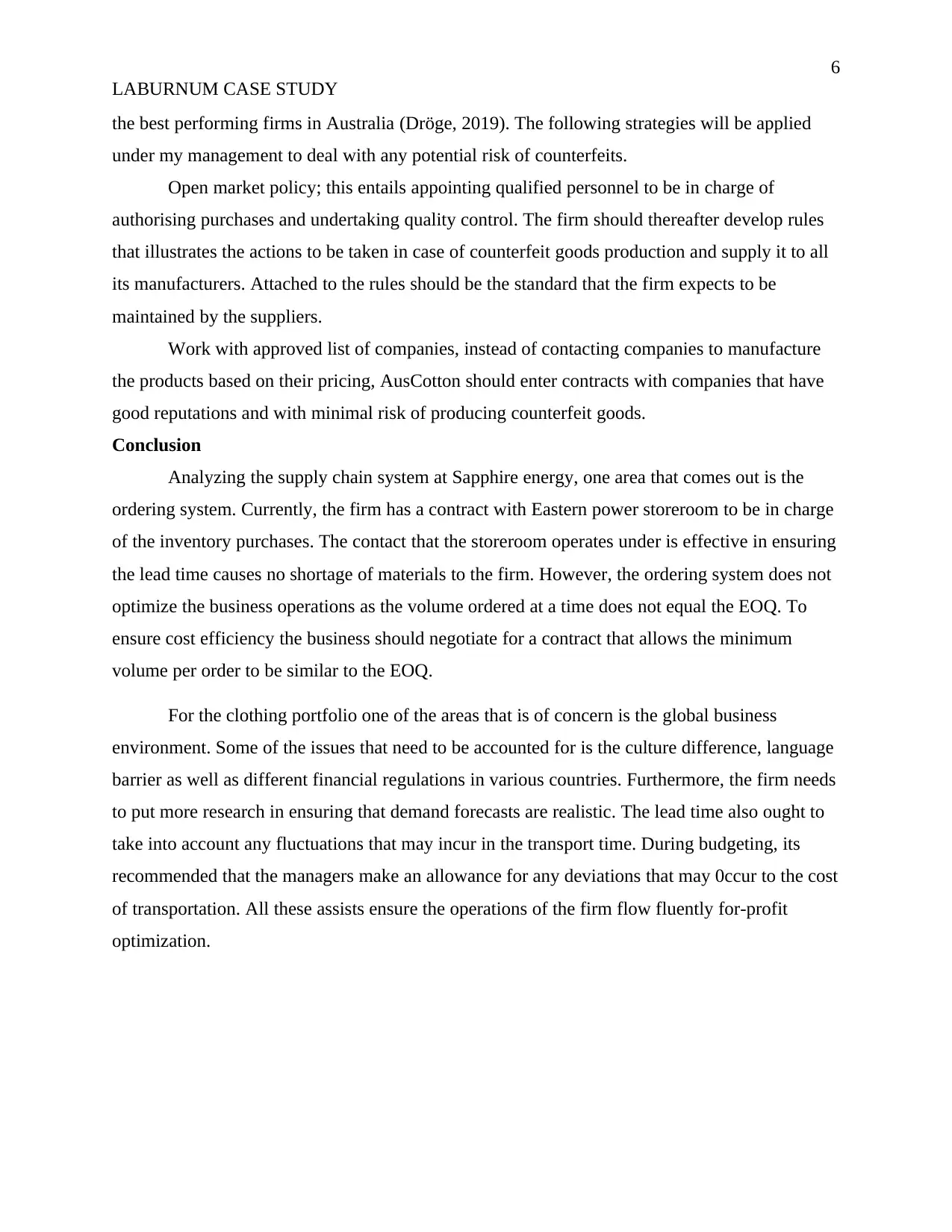
6
LABURNUM CASE STUDY
the best performing firms in Australia (Dröge, 2019). The following strategies will be applied
under my management to deal with any potential risk of counterfeits.
Open market policy; this entails appointing qualified personnel to be in charge of
authorising purchases and undertaking quality control. The firm should thereafter develop rules
that illustrates the actions to be taken in case of counterfeit goods production and supply it to all
its manufacturers. Attached to the rules should be the standard that the firm expects to be
maintained by the suppliers.
Work with approved list of companies, instead of contacting companies to manufacture
the products based on their pricing, AusCotton should enter contracts with companies that have
good reputations and with minimal risk of producing counterfeit goods.
Conclusion
Analyzing the supply chain system at Sapphire energy, one area that comes out is the
ordering system. Currently, the firm has a contract with Eastern power storeroom to be in charge
of the inventory purchases. The contact that the storeroom operates under is effective in ensuring
the lead time causes no shortage of materials to the firm. However, the ordering system does not
optimize the business operations as the volume ordered at a time does not equal the EOQ. To
ensure cost efficiency the business should negotiate for a contract that allows the minimum
volume per order to be similar to the EOQ.
For the clothing portfolio one of the areas that is of concern is the global business
environment. Some of the issues that need to be accounted for is the culture difference, language
barrier as well as different financial regulations in various countries. Furthermore, the firm needs
to put more research in ensuring that demand forecasts are realistic. The lead time also ought to
take into account any fluctuations that may incur in the transport time. During budgeting, its
recommended that the managers make an allowance for any deviations that may 0ccur to the cost
of transportation. All these assists ensure the operations of the firm flow fluently for-profit
optimization.
LABURNUM CASE STUDY
the best performing firms in Australia (Dröge, 2019). The following strategies will be applied
under my management to deal with any potential risk of counterfeits.
Open market policy; this entails appointing qualified personnel to be in charge of
authorising purchases and undertaking quality control. The firm should thereafter develop rules
that illustrates the actions to be taken in case of counterfeit goods production and supply it to all
its manufacturers. Attached to the rules should be the standard that the firm expects to be
maintained by the suppliers.
Work with approved list of companies, instead of contacting companies to manufacture
the products based on their pricing, AusCotton should enter contracts with companies that have
good reputations and with minimal risk of producing counterfeit goods.
Conclusion
Analyzing the supply chain system at Sapphire energy, one area that comes out is the
ordering system. Currently, the firm has a contract with Eastern power storeroom to be in charge
of the inventory purchases. The contact that the storeroom operates under is effective in ensuring
the lead time causes no shortage of materials to the firm. However, the ordering system does not
optimize the business operations as the volume ordered at a time does not equal the EOQ. To
ensure cost efficiency the business should negotiate for a contract that allows the minimum
volume per order to be similar to the EOQ.
For the clothing portfolio one of the areas that is of concern is the global business
environment. Some of the issues that need to be accounted for is the culture difference, language
barrier as well as different financial regulations in various countries. Furthermore, the firm needs
to put more research in ensuring that demand forecasts are realistic. The lead time also ought to
take into account any fluctuations that may incur in the transport time. During budgeting, its
recommended that the managers make an allowance for any deviations that may 0ccur to the cost
of transportation. All these assists ensure the operations of the firm flow fluently for-profit
optimization.
⊘ This is a preview!⊘
Do you want full access?
Subscribe today to unlock all pages.

Trusted by 1+ million students worldwide
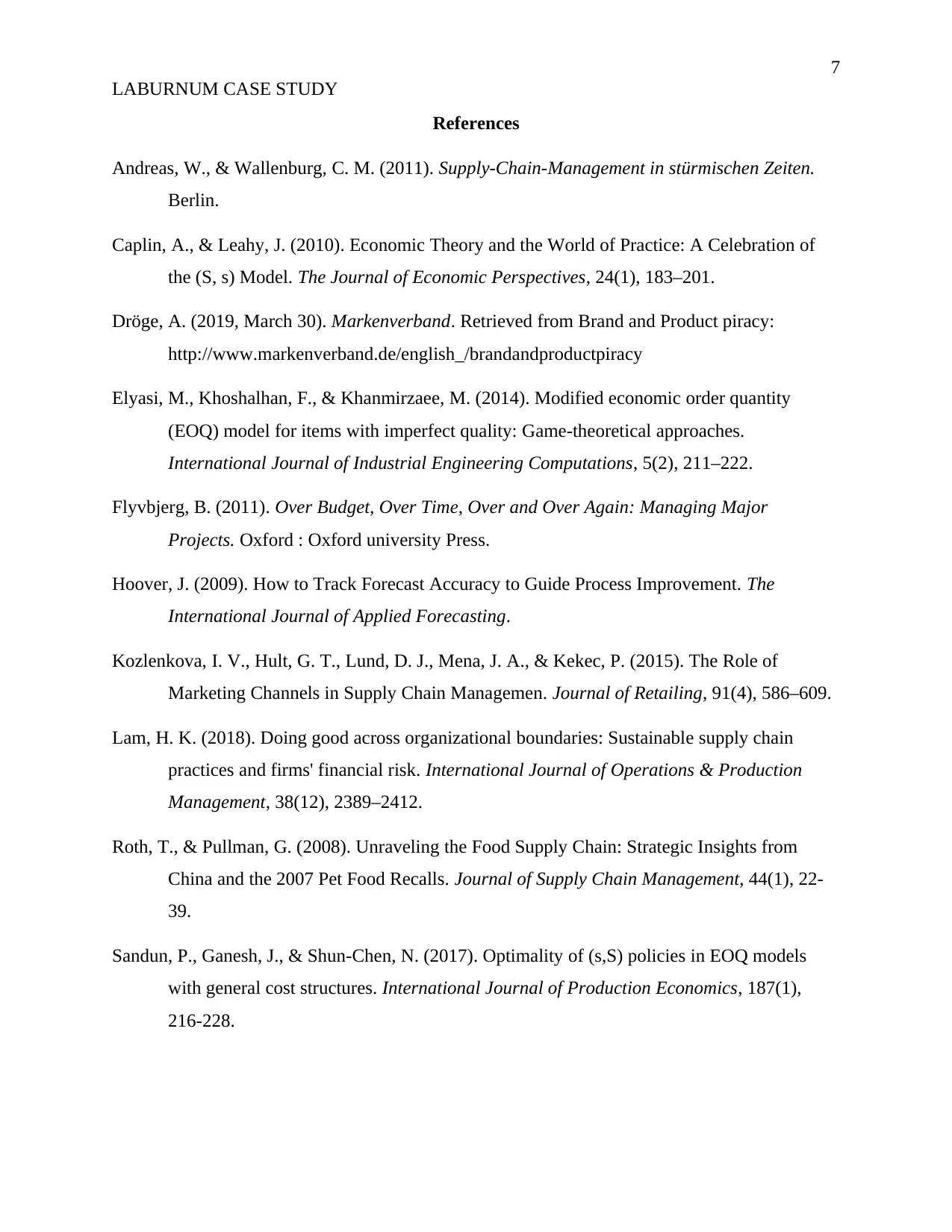
7
LABURNUM CASE STUDY
References
Andreas, W., & Wallenburg, C. M. (2011). Supply-Chain-Management in stürmischen Zeiten.
Berlin.
Caplin, A., & Leahy, J. (2010). Economic Theory and the World of Practice: A Celebration of
the (S, s) Model. The Journal of Economic Perspectives, 24(1), 183–201.
Dröge, A. (2019, March 30). Markenverband. Retrieved from Brand and Product piracy:
http://www.markenverband.de/english_/brandandproductpiracy
Elyasi, M., Khoshalhan, F., & Khanmirzaee, M. (2014). Modified economic order quantity
(EOQ) model for items with imperfect quality: Game-theoretical approaches.
International Journal of Industrial Engineering Computations, 5(2), 211–222.
Flyvbjerg, B. (2011). Over Budget, Over Time, Over and Over Again: Managing Major
Projects. Oxford : Oxford university Press.
Hoover, J. (2009). How to Track Forecast Accuracy to Guide Process Improvement. The
International Journal of Applied Forecasting.
Kozlenkova, I. V., Hult, G. T., Lund, D. J., Mena, J. A., & Kekec, P. (2015). The Role of
Marketing Channels in Supply Chain Managemen. Journal of Retailing, 91(4), 586–609.
Lam, H. K. (2018). Doing good across organizational boundaries: Sustainable supply chain
practices and firms' financial risk. International Journal of Operations & Production
Management, 38(12), 2389–2412.
Roth, T., & Pullman, G. (2008). Unraveling the Food Supply Chain: Strategic Insights from
China and the 2007 Pet Food Recalls. Journal of Supply Chain Management, 44(1), 22-
39.
Sandun, P., Ganesh, J., & Shun-Chen, N. (2017). Optimality of (s,S) policies in EOQ models
with general cost structures. International Journal of Production Economics, 187(1),
216-228.
LABURNUM CASE STUDY
References
Andreas, W., & Wallenburg, C. M. (2011). Supply-Chain-Management in stürmischen Zeiten.
Berlin.
Caplin, A., & Leahy, J. (2010). Economic Theory and the World of Practice: A Celebration of
the (S, s) Model. The Journal of Economic Perspectives, 24(1), 183–201.
Dröge, A. (2019, March 30). Markenverband. Retrieved from Brand and Product piracy:
http://www.markenverband.de/english_/brandandproductpiracy
Elyasi, M., Khoshalhan, F., & Khanmirzaee, M. (2014). Modified economic order quantity
(EOQ) model for items with imperfect quality: Game-theoretical approaches.
International Journal of Industrial Engineering Computations, 5(2), 211–222.
Flyvbjerg, B. (2011). Over Budget, Over Time, Over and Over Again: Managing Major
Projects. Oxford : Oxford university Press.
Hoover, J. (2009). How to Track Forecast Accuracy to Guide Process Improvement. The
International Journal of Applied Forecasting.
Kozlenkova, I. V., Hult, G. T., Lund, D. J., Mena, J. A., & Kekec, P. (2015). The Role of
Marketing Channels in Supply Chain Managemen. Journal of Retailing, 91(4), 586–609.
Lam, H. K. (2018). Doing good across organizational boundaries: Sustainable supply chain
practices and firms' financial risk. International Journal of Operations & Production
Management, 38(12), 2389–2412.
Roth, T., & Pullman, G. (2008). Unraveling the Food Supply Chain: Strategic Insights from
China and the 2007 Pet Food Recalls. Journal of Supply Chain Management, 44(1), 22-
39.
Sandun, P., Ganesh, J., & Shun-Chen, N. (2017). Optimality of (s,S) policies in EOQ models
with general cost structures. International Journal of Production Economics, 187(1),
216-228.
Paraphrase This Document
Need a fresh take? Get an instant paraphrase of this document with our AI Paraphraser

8
LABURNUM CASE STUDY
LABURNUM CASE STUDY
1 out of 8
Related Documents
Your All-in-One AI-Powered Toolkit for Academic Success.
+13062052269
info@desklib.com
Available 24*7 on WhatsApp / Email
![[object Object]](/_next/static/media/star-bottom.7253800d.svg)
Unlock your academic potential
© 2024 | Zucol Services PVT LTD | All rights reserved.





